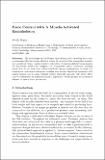Force Control with A Muscle-Activated Endoskeleton
Author(s)
Hogan, Neville
DownloadHogan-2006-Force Control.pdf (328.5Kb)
MIT_AMENDMENT
MIT Amendment
Article is made available in accordance with the publisher's policy and may be subject to US copyright law. Please refer to the publisher's site for terms of use.
Terms of use
Metadata
Show full item recordAbstract
The advantages and challenges of producing and controlling force with a mechanism like the human skeleton driven by actuators like mammalian muscles are considered. Some counter-intuitive subtleties of musculo-skeletal biomechanics are discovered: despite the energetic cost of isometric muscle activation, exerting forces that do no work may reduce metabolic energy consumption; in some circumstances, anatomical antagonist muscles may become functional synergists; and muscle tension acts to make skeletal posture statically unstable. The latter effect can be counteracted by muscle mechanical impedance, which emerges as an essential adjunct to muscle force production.
Date issued
2006Department
Massachusetts Institute of Technology. Department of Brain and Cognitive Sciences; Massachusetts Institute of Technology. Department of Mechanical EngineeringJournal
Advances in Robot Control
Publisher
Springer-Verlag
Citation
Hogan, Neville. “Force Control with A Muscle-Activated Endoskeleton.” Advances in Robot Control. Ed. Sadao Kawamura & Mikhail Svinin. Berlin, Heidelberg: Springer Berlin Heidelberg. 201–216. Web. 13 Apr. 2012.
Version: Final published version
ISBN
978-3-540-37347-6
978-3-540-37346-9